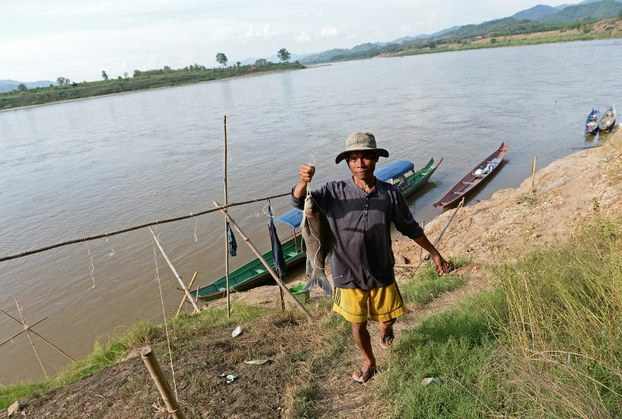




Thailand, after suspending action for more than a decade, has decided to support China’s blasting of rapids in the Mekong River.
China wants to remove rocks and islets in the Mekong in order to clear the way for large cargo ships, effectively turning Southeast Asia’s longest river into a Chinese trade and shipping lane.
Thailand’s military government meanwhile has plans to build a multimillion dollar freight transport hub in the country’s northern province of Chiang Rai. The aim is to link Chinese shipping with Thai land transport.
The city of Chiang Rai would be promoted as a logistics hub for Thailand and both China and neighboring Laos. Construction is scheduled to begin next year, according to The Bangkok Post.
The Post says that the blasting will cover a 392-mile route from the China-Myanmar border to Luang Prabang in Laos.
But nongovernmental groups in Thailand argue that the loss of the rapids will further damage the Mekong’s declining fish stocks, which have long been the major source of protein for villagers living near the river.
Pianporn Deetes, Thailand campaign coordinator for the NGO International Rivers, said that the ecosystem in question is one of the most complex in the world. It includes many fish species, rapids, whirlpools, and sand dunes as well as vegetation supporting farmers, fishermen, and wildlife.
The rapids and rocks provide sanctuaries and breeding grounds for migratory fish. They also provide a refuge for the endangered giant catfish.
Deetes said in an interview that to place commercial shipping ahead of the needs of millions of farmers and fishermen depending on the Mekong for their living would be “senseless .”
She said that export products from China can reach Thai markets within 24 hours by road and that existing shipping by smaller cargo ships is working well. In addition, she noted that China has plans to build a railroad inside Laos that will be able to carry freight to Thailand.
Thai villagers protest
Over the past year, Thai villagers living along the Mekong have boarded Chinese survey boats to protest plans to destroy the rapids located near their homes.
Living on the Thai side of the Mekong, which forms a border between Laos and Thailand, the villagers have demanded that the survey boats halt their work.
At the same time, a group of Thai villagers led by a Thai teacher called Kru Tee filed a lawsuit in Thailand calling for a judgment against several Thai government agencies regarding the negative environmental and social impacts created by Laos’s Xayaburi Dam.
The plaintiffs argued that the hydropower dam wouldn’t have been economically viable without an agreement by the Electricity Generating Authority of Thailand (EGAT) to purchase 95 percent of the electricity generated by the dam.
The case came under investigation by Thailand’s Supreme Administrative Court, but according to Thai media, it was rejected in late December, 2015.
A history of debate
In the year 2000, China, Laos, Burma, and Thailand signed an agreement to allow the blasting of rocks and reefs in the Mekong River.
According to a report by the Worldwatch Institute based in Washington, D.C., blasting began in December 2002.
But in 2003, after completing an early phase of the project, China halted the dynamiting due to a Thai border dispute with Laos over the location of the two countries’ shared water boundary.
Thai officials feared that changes in the flow of the river resulting from the blasting could shift the location of the Thai-Lao border, which is supposed to be set at the lowest elevation within the river.
Meanwhile, China had undertaken an environmental impact study which concluded that the impact of the blasting would be negligible.
But a Thai environmental watchdog group and scientists who reviewed the Chinese findings said that the study’s analysis was deeply flawed. They said, moreover, that it was based on a field investigation that had lasted only two days.
The Mekong River Commission (MRC), which is supposed to review major changes in the flow of the Mekong, has called for a halt to the plan to blast more rapids until a more complete study can be made. But the MRC’s findings are not binding, and China isn’t a member of the commission.
The new blasting is not likely to commence until three years from now under a framework that called for a first phase from 2015 to 2020. That phase has required a survey and another assessment of the project’s impact.
But some critics argue that even the smaller ships that currently carry cargo down the Mekong are already causing erosion of the riverbanks along parts of the river.
“Without the blasting of more rapids, local people feel the shipping traffic is already very destructive,” said former Thai Senator Kraisak Choonhavan, who has studied the issues involved for several decades.
Dan Southerland is RFA’s founding executive editor.